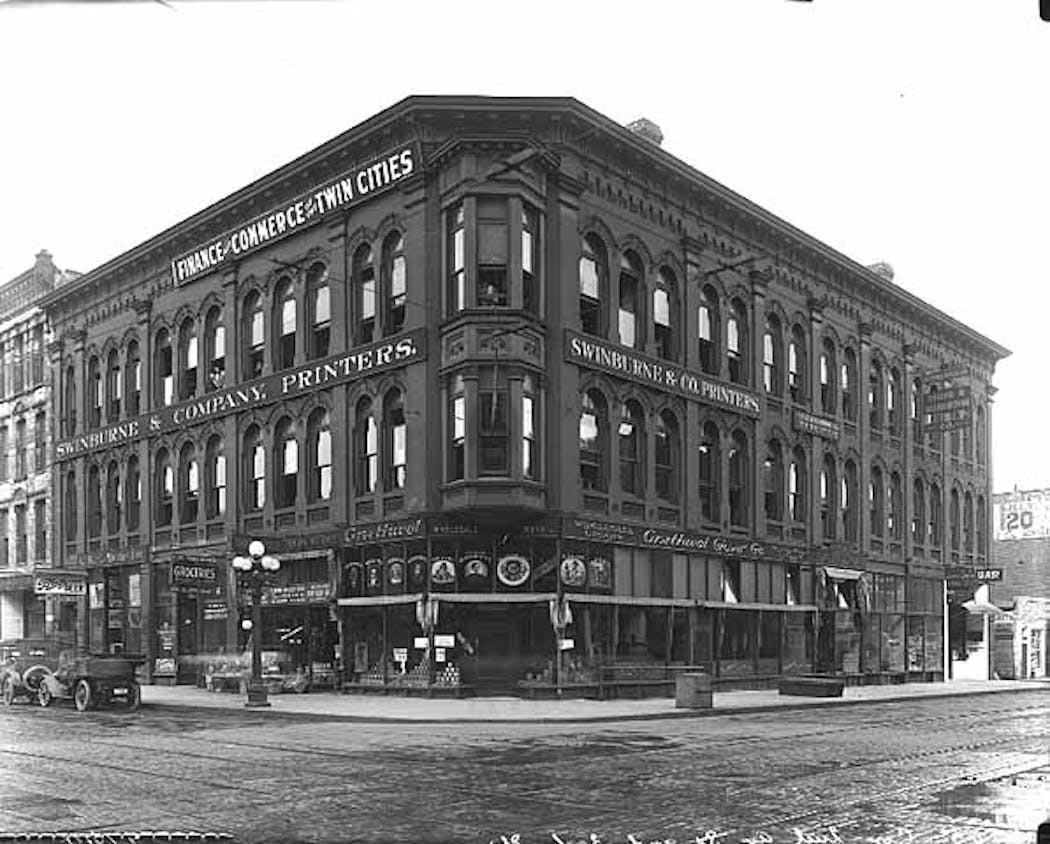Buildings, like people, often have complicated lives.
Among the thousands of buildings that have come and gone over the years in Minneapolis, few went through as many lives as Harmonia Hall, which stood for more than 75 years at 3rd Street and 2nd Avenue S.
Built primarily as a home for orchestral and choral music, the hall later became home to a vaudeville theater, a printing business, offices, shops, restaurants and, in its last days, a down-at-the-heels hotel.
Along the way, as one use morphed into another, the building experienced a devastating fire and underwent multiple surgeries, including one entailing the amputation of its tower and top floor.
Despite its rich history, the hall — only a few images of which survive in public collections —is barely known today, possibly because for most of its life it stood kitty-corner to the legendary Metropolitan Building, which tended to steal the show when it came to photographic attention.
The hall was built by the Harmonia Singing Society, an organization founded in the early 1860s by members of Minneapolis' German community. The society built its first hall at 2nd Street and 1st Avenue N.
By the mid-1880s, Minneapolis had grown into a booming metropolis. The benighted people of those misty days of yore had to survive without Netflix, so they amused themselves with live entertainment of all kinds. The 218-member Harmonia Society decided to meet this growing demand by building a large new hall for concerts, operas, plays and other events.
The hall, which opened in December 1884, was a full-blown example of the busy, colorful Victorian Gothic commercial style that enjoyed a brief run in the Twin Cities in the 1880s.
Its Norwegian-born architect, Carl Struck, who does not seem to have fit the gloomy Scandinavian stereotype, also designed the equally colorful Dania Hall (lost to fire in 2000) in the Cedar-Riverside neighborhood, as well as the you-have-to-see-it-to-believe-it Moorish confection known as the Bardwell-Ferrant House at 2500 Portland Av. S.
Featuring reddish brick walls threaded with bands of white Ohio sandstone, Harmonia Hall displayed its Gothic roots via long rows of pointed-arch windows on the upper floors. Capping the composition was a mansarded attic bristling with dormers and pinnacles. An angled corner tower rising above bay windows added a final note of Victorian exuberance.
Within, a horseshoe-shaped auditorium took up most of the second and third floors, along with rehearsal and club rooms. I've never seen an image of the auditorium, but descriptions indicate it seated about 1,000 people and had excellent acoustics.
The Tribune reported on the hall's grand opening, which featured a concert, speeches (in German) and a dinner followed by music and dancing. An "eastern gentleman" quoted in the story hailed the building as "the most complete and convenient hall for a large society in the west."
Concerts were the hall's early staple. The Frank Danz Orchestra, considered a forerunner of the Minneapolis Symphony Orchestra (now the Minnesota Orchestra), performed regularly, as did other groups.
The hall wasn't limited to German performers, however. Scandinavian and Irish organizations, among others, also used the hall, which hosted an array of events ranging from bazaars and conferences to an annual "orphans fair" that helped support the Catholic Boys Home in Minneapolis.
Those fairs, held in the 1880s and 1890s, included as many as 80 orphans in attendance and came with a distinct moral message, as summarized by the Tribune in 1893: "Unless guided and aided by the public hand of charity, these orphans would drift into all kinds of vice. The children were saved from the gutter and raised into noble citizenship." At least, that was the idea.
But saving orphans didn't help the Harmonia Society Save itself. A financial crash in 1893 plunged the nation into what was then the worst depression in its history, and the society ultimately disbanded after defaulting on the hall's mortgage.
Meanwhile, the hall itself remained open, although it struggled financially. In 1899, as the depression finally lifted, the hall was remodeled to become a vaudeville theater, its operators promising that only the finest traveling acts would be booked. The new arrangement wasn't a success, however, and the vaudeville shows ended in less than a year.
Then, in January of 1905, fire roared through the upper floors of the hall, destroying the auditorium and the attic. Six people, including a couple with a new baby, managed to escape but not before the baby was dropped 23 feet from a fire escape into the waiting arms of a district fire chief.
Rebuilding ensued, but the hall's days as an entertainment venue were over.
But for many years the building functioned largely as a cheap hotel. By the 1950s it was known as the Rex Hotel (for men only) and offered rooms for as little as $5.50 a week.
When the city approved the Gateway Urban Renewal Plan in 1958, the old hall's fate was sealed. It came down in 1961–62 just as the far more prominent Metropolitan Building was being razed.
Today, the Wells Fargo Operations Center, a building untainted by charm, fills the block where Harmonia Hall once stood as a testament to an immigrant community's love of music.
Larry Millett is an architecture critic and author. He can be reached at larrymillett.com.

The 5 best things our food writers ate this week

A Minnesota field guide to snow shovels: Which one's best?

Summer Camp Guide: Find your best ones here

Lowertown St. Paul losing another restaurant as Dark Horse announces closing




